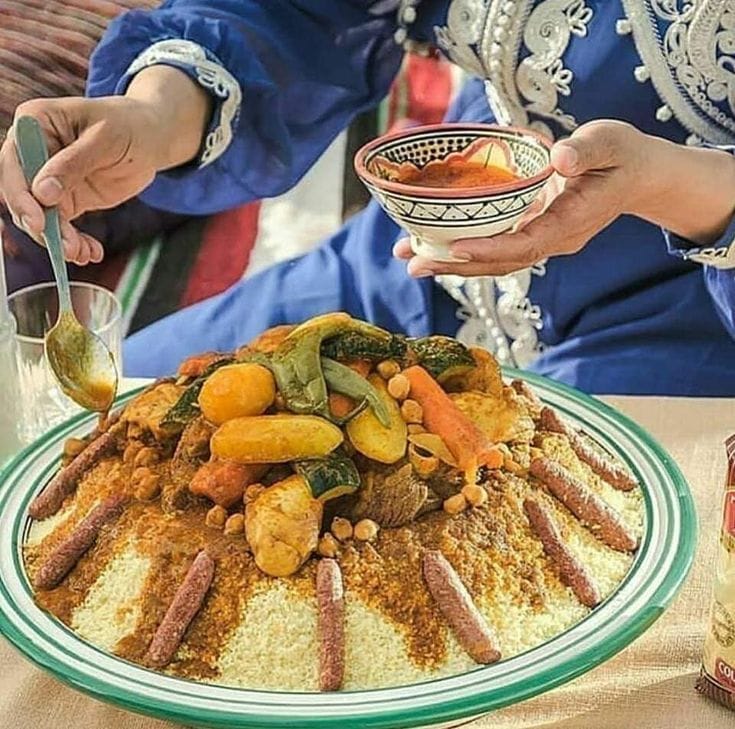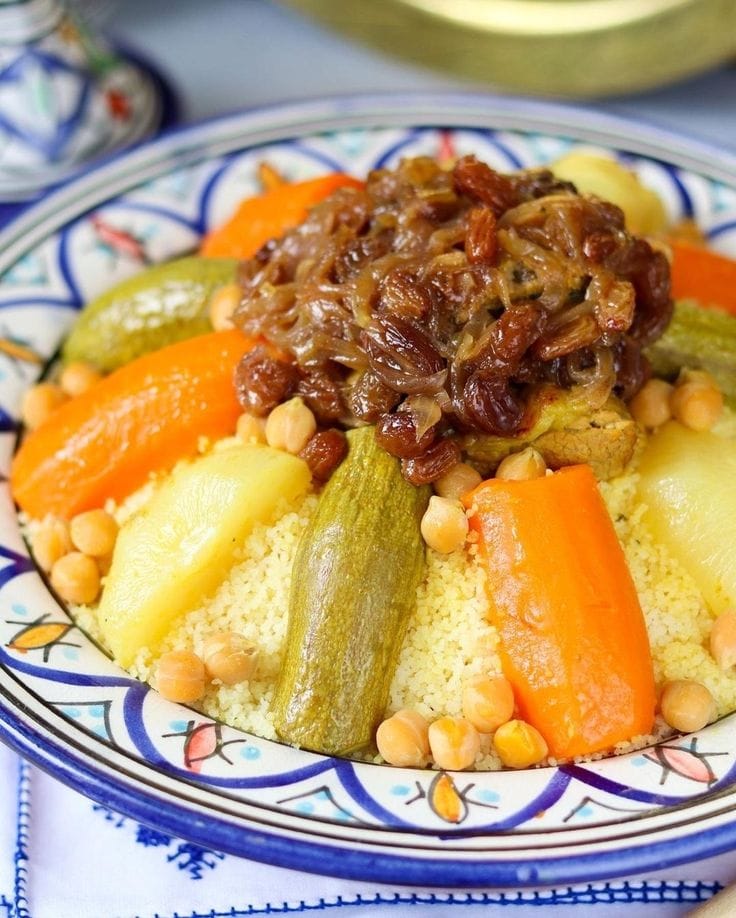Introduction to Moroccan Couscous Recipe
Embark on a culinary voyage with our Authentic Moroccan Couscous Recipe, where tradition meets flavor in a harmonious blend. This time-honored dish showcases the rich heritage of Moroccan cuisine, offering a tantalizing experience for your taste buds. Immerse yourself in the intricate spices and textures that define this iconic Moroccan Couscous Recipe, a true masterpiece of culinary art.
In this guide, you’ll learn how to make authentic Moroccan couscous from scratch, including key ingredients, step-by-step cooking instructions, and tips to perfect the dish. We’ll also explore its health benefits and regional variations.
What Is Moroccan Couscous?
Couscous is a type of semolina pasta, typically made from durum wheat. In Morocco, couscous is steamed rather than boiled, creating a fluffy, light texture that perfectly absorbs savory broths.
What makes the Moroccan couscous recipe stand out is the flavorful broth infused with vegetables, chickpeas, and either lamb, beef, or chicken, along with signature spices such as ginger, turmeric, cumin, and cinnamon.
Health Benefits of Moroccan Couscous
Before we dive into the recipe, it’s worth noting that Moroccan couscous is not only delicious but also incredibly nutritious. Here are some of its health benefits:
- Rich in fiber from vegetables and chickpeas
- Low in fat (especially vegetarian versions)
- Source of plant-based protein
- Packed with antioxidants from spices like turmeric and cinnamon
- Supports digestive health due to high fiber content
Couscous is a great option for those looking to maintain a balanced diet while enjoying satisfying, traditional food.
Ingredients for Moroccan Couscous Recipe
For the Couscous:
- 2 cups dry couscous (semolina)
- 2 tablespoons olive oil
- 1 teaspoon salt
- 2 cups warm water
For the Vegetable and Meat Stew:
- 2 tablespoons olive oil
- 1 large onion, chopped
- 2 cloves garlic, minced
- 2 carrots, peeled and cut into chunks
- 2 zucchinis, chopped
- 2 turnips, peeled and quartered
- 1 small cabbage, quartered
- 2 tomatoes, chopped
- 1 large potato, peeled and cubed
- 1 cup chickpeas, soaked overnight
- 1 ½ pounds lamb, beef, or chicken, bone-in
- 1 teaspoon ground ginger
- 1 teaspoon turmeric
- 1 teaspoon ground cumin
- ½ teaspoon cinnamon
- Salt and pepper to taste
- 6 cups water or broth
- Optional: 1 small hot chili pepper for heat

Step-by-Step Moroccan Couscous Recipe
Step 1: Prepare the Broth
- In a large pot or couscoussier (steamer pot), heat olive oil over medium heat.
- Add chopped onions and garlic. Sauté until translucent.
- Add meat, and brown on all sides.
- Stir in spices: ginger, turmeric, cumin, cinnamon, salt, and pepper. Mix well.
- Add tomatoes, chickpeas, and 6 cups of water or broth. Bring to a boil.
- Cover and simmer on low heat for 30–40 minutes, allowing the flavors to deepen.
Step 2: Add the Vegetables
- Add hard vegetables first: carrots, turnips, and potatoes. Cook for 10 minutes.
- Then add zucchini, cabbage, and any softer vegetables. Continue simmering for another 20–25 minutes or until all vegetables are tender.
Step 3: Prepare the Couscous
- In a large bowl, place dry couscous and sprinkle with 2 tablespoons of olive oil and salt. Rub gently between your hands to coat grains.
- Add warm water gradually and fluff the grains with a fork. Let it absorb for 10 minutes.
- Transfer couscous to the top of a steamer or couscoussier. Steam over the simmering stew for about 20 minutes.
- Return couscous to the bowl, add a little water, fluff with a fork, and repeat steaming once or twice for optimal fluffiness.
Step 4: Final Assembly
- Place couscous in a large serving dish.
- Arrange meat and vegetables on top.
- Ladle some broth over the couscous and serve extra broth on the side.
- Garnish with fresh parsley, if desired.
Expert Tips for Perfect Moroccan Couscous
- Use a couscoussier if available. This traditional steamer ensures fluffy couscous.
- Don’t skip the double or triple steaming. This technique keeps couscous light and separate.
- Always soak chickpeas overnight to reduce cooking time.
- Season in layers—season the meat first, then adjust after adding vegetables.
Variations of Moroccan Couscous
Moroccan couscous recipes vary by region, season, and family tradition. Here are some popular versions:
1. Couscous with Seven Vegetables (Couscous Bidaoui)
A classic Friday dish featuring seven types of vegetables symbolizing abundance.
2. Couscous Tfaya
Sweet and savory version made with caramelized onions, raisins, cinnamon, and sometimes almonds.
3. Couscous with Fish
Popular in coastal regions. Made with white fish and chermoula (Moroccan herb marinade).
4. Vegetarian Couscous
Perfect for plant-based diets. Loaded with vegetables and chickpeas—no meat included.

Why You’ll Love This Moroccan Couscous Recipe
- It’s authentic, passed down from Moroccan home kitchens.
- It’s balanced—a complete meal with carbs, protein, and fiber.
- It’s adaptable—can be made vegetarian, vegan, or with your favorite protein.
- It’s satisfying, hearty, and perfect for family dinners or gatherings.
Serving Suggestions
Moroccan couscous is traditionally served with:
- Harissa (spicy chili paste) for a kick
- Fresh bread like khobz or batbout
- Mint tea to cleanse the palate
- Seasonal fruits or pastries for dessert
Make-Ahead and Storage Tips
- Leftovers can be stored in the fridge for up to 3 days.
- Couscous and broth should be stored separately to avoid sogginess.
- Reheat couscous by steaming again or sprinkling with water and microwaving.
FAQs About Moroccan Couscous
What is the secret to fluffy couscous?
The key is to steam couscous multiple times and fluff it in between. Don’t boil it like pasta.
Can I use instant couscous?
Yes, for convenience. But for authentic Moroccan flavor, traditional steaming is recommended.
Is Moroccan couscous gluten-free?
No, traditional couscous is made from wheat semolina, so it’s not gluten-free.
What meat is best for Moroccan couscous?
Lamb is traditional, but chicken or beef are also commonly used depending on the region.
Final Thoughts
The Moroccan couscous recipe is a celebration of culture, history, and incredible flavors. Whether you’re preparing it for a Friday lunch, Ramadan, or just to try something new, this dish offers a delightful taste of Morocco’s rich culinary heritage.
By following this step-by-step recipe and using traditional ingredients and techniques, you’ll be able to create a delicious meal that brings people together and warms the heart.
So go ahead—try making Moroccan couscous today, and share this dish with your loved ones. It’s more than just food; it’s an experience.
